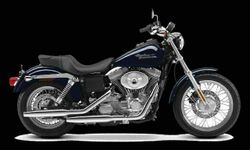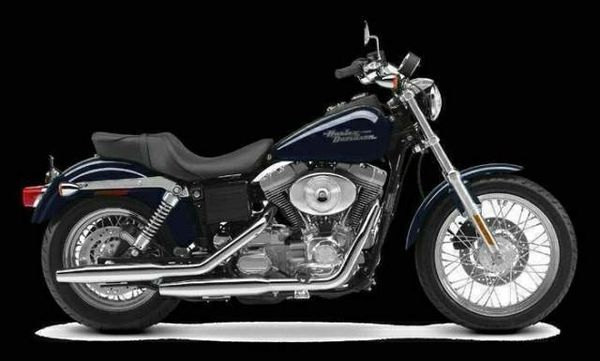Harley-Davidson FXD/I Dyna Super Glide
 |
|
| Harley-Davidson FXD/I Dyna Super Glide | |
| Manufacturer | |
|---|---|
| Production | 1999 - 00 |
| Engine | Four stroke, 45° V-Twin, Twin Cam 88® vibration isolation-mounted Valves Pushrod-operated overhead valves; w/ hydraulic self-adjusting lifters; two valves per cylinder |
| Compression ratio | 8.9:1 |
| Ignition | Single-fire, non-wasted, map-controlled spark ignition |
| Transmission | 5 Speed |
| Frame | Mild steel, tubular frame; rectangular section backbone; stamped, cast and forged junctions, forged fender supports; MIG welded |
| Suspension | Front: 39 mm w/ polished aluminum fork triple clamp and dual-rate springs Rear: Coil over shock |
| Brakes | Front: Single 292mm disc 4 piston calipers Rear: Single 292mm disc 4 piston calipers |
| Front Tire | 100/90-19 |
| Rear Tire | MT90 B16 |
| Wheelbase | 1630.0 mm / 64.2 in |
| Seat Height | Laden2 675.6 mm / 26.6 in Unladen 700.0 mm / 27.6 in |
| Weight | 287 kg / 632.2 lbs (dry), 301 kg / 663 lbs (wet) |
| Fuel Capacity | 18.6 Liters / 4.8 US gal |
| Manuals | Service Manual |
Engine[edit | edit source]
The engine was a Air cooled cooled Four stroke, 45° V-Twin, Twin Cam 88® vibration isolation-mounted Valves Pushrod-operated overhead valves; w/ hydraulic self-adjusting lifters; two valves per cylinder. The engine featured a 8.9:1 compression ratio.
Drive[edit | edit source]
Power was moderated via the Wet 9-plate.
Chassis[edit | edit source]
It came with a 100/90-19 front tire and a MT90 B16 rear tire. Stopping was achieved via Single 292mm disc 4 piston calipers in the front and a Single 292mm disc 4 piston calipers in the rear. The front suspension was a 39 mm w/ polished aluminum fork triple clamp and dual-rate springs while the rear was equipped with a Coil over shock. The FXD/I Dyna Super Glide was fitted with a 18.6 Liters / 4.8 US gal fuel tank. The bike weighed just 287 kg / 632.2 lbs. The wheelbase was 1630.0 mm / 64.2 in long.
Photos[edit | edit source]
Overview[edit | edit source]
Harley Davidson
FXD Dyna Super Glide
Let's start another urban myth.
A lady named Sheila Boyle once told us a story of her 1975 Super Glide. She
said way back in the mid-seventies Willie G. Davidson (H-D's vice-president
of styling and member of the royal family) paid a visit to her
then-husband's Harley shop, Harley-Davidson West, at that time the world's
largest. Allegedly, when Willie G. saw her customized Super Glide with
shorter shocks, cut down seat and other custom goodies his jaw dropped. Sure
enough, a year or two later the Low Rider was born.
Myth or not, in 1977 Harley-Davidson's Low Rider was introduced at Daytona
Bike Week. Dubbed the FXS, it was the first of Harley's "factory customs"
that would later include the Bad Boy, Road King, Fat Boy and the epic
Heritage Springer. In addition to a low seat height, features on that first
Low Rider included raised white lettered tires, drag bars, mag wheels, and
an oft-copied two-into-one slash-cut exhaust. The bike was an instant hit,
inspiring Willie G. and his staff to create even more custom models - a
trend that continues today.
The eighties saw a rise of H-D's rubber-mounted FXR chassis to replace their aging solid-mounted FX line. Naturally the Low Rider followed with the FXRS model. This Low Rider was graced with dual disk brakes, a pop-up seat for easy battery access and low rise bars. With the migration to the FXR platform came the more significant development of the Evolution engine. Harley was plagued throughout the seventies with a rapidly deteriorating powerplant - the Shovelhead. In 1984, the introduction of their all-alloy Evolution (or Blockhead) engine solved virtually all of the Shovelhead's woes (with more advanced features like better oiling, tighter seals through newer tooling and easier maintenance), while still retaining the same general look. It took awhile to drop the stigma of Harleys being oil-leakers and prone to breakdowns, but their image seems to have swung 'round full circle. Welcome to the nineties, and the Dyna chassis. The Dyna was Harley-Davidson's first CAD-designed model, and featured an advanced engine isolation system. The new set-up allowed more engine shake at idle, but less at speed, resulting in vibration-free mirrors (and seat) during highway cruising. This is opposed to the FXR's slightly-damped, but ever-present vibes. When the FXR fell into extinction in 1995, the humble Low Rider was re-christened the FXDL Dyna Low Rider and given a new skin. For those of you familiar with the current Dyna platform, you may want to skip the next few paragraphs. For the rest of you Dyna neophytes, pay attention. The Low Rider's chassis shares all of the features and flaws of its siblings. The Dyna frame is sort of Harley's version of a perimeter frame. Differing from all other H-D frames, it has no center tube crossing between the engine and transmission -- just a wreath of steel encircling the entire powerplant/transmission. In stock configuration it performs beautifully, but how many Harleys remain stock? In performance-modified form, the Evo engine will tend to break inner-primary cases, due to stresses placed on this piece in the "fully isolated" configuration of the bike. Luckily, the aftermarket has developed a workaround in the form of a brace for the bike's right side to spread the torque produced by a bored, stroked, or otherwise modified powerplant. Another customizer's nightmare can be found in the beautiful full fender that extends almost all the way to the swingarm. When lowering a Dyna, the fender has to be cut and re-painted to avoid catastrophic damage to this piece when you hit a bump. Other nit-picks include a goofy key position behind the seat on the right side, passenger footpegs that look like an afterthought and excessive vibration at idle from the very loosely isolated engine. On the up side, the Dyna chassis has greater rigidity that its FXR predecessor for better handling, increased vibration damping at speed (as mentioned earlier), plus a hidden crossover tube on the rubber-mounted exhaust pipes and easily accessed electronics. The Low Rider was a motorcycle made to buck tradition when it was first introduced in 1977, and it remains so today.
"We conducted an informal online survey on the topic of buckhorns vs. no buckhorns. The results from our daily news." Other than a narrow front end there is little of the original FXS in the FXDL. The mag wheels, once thought to be trick in the seventies, are blase today so the FXDL sports laced wheels. The FXS had sporty drag-style handlebars, while the Dyna comes equipped with buckhorns. A quick survey of everyone in our office revealed that not one of us likes buckhorns, while Harley's PR department maintains they are the number one accessory item sold. What gives? Maybe you can help.
What remains of the original Low Rider is attention to detail. Wrinkled black paint and chrome adorn most surfaces of this motorcycle. Handy highway pegs add comfort on the interstate. A detachable passenger seat doubles as a driver backrest, offering a little extra comfort - or a different look. A fuel gauge tops the dummy gas cap on the left side of the tank, hitting empty after around 180 miles of riding. The new-for-97 spring rates are perfect for a blast through the twisties, with only the limited leverage from those buckhorns impeding the fun. On the open road suspension is smooth and supple, allowing hours to pass unnoticed. Popular add-on item or not, we just didn't care for the buckhorn handlebars, and we were also less than enthusiastic about the mid-mount foot controls. However, all agreed that as a customization platform, the Low Rider was untouchable. Maybe put some of Harley's cool forward controls and a set of drag bars on it, and you'll have a machine to envy. Is this the Low Rider of old, updated for the ninties? Absolutely not. In fact about the only thing Harley's 1997 Dyna Low Rider has in common with the original FXS is a low seat height and the Narrow-Glide front end that, incidentally, has grown in fork size from a spindly 35mm to a more modern 39mm. What they do share is Willie G.'s flair for style and that wonderful potato exhaust note. Source
| Make Model | Harley Davidson FXD/I Dyna Super Glide |
|---|---|
| Year | 1999 - 00 |
| Engine Type | Four stroke, 45° V-Twin, Twin Cam 88® vibration isolation-mounted Valves Pushrod-operated overhead valves; w/ hydraulic self-adjusting lifters; two valves per cylinder |
| Displacement | 1449 cc / 88.4 cu-in |
| Bore X Stroke | 95.3 x 101.6 mm |
| Cooling System | Air cooled |
| Compression | 8.9:1 |
| Lubrication | Dry sump, internally mounted, crank driven gerotor pressure and dual scavenge pump with spin on 10ì pressurized oil filter |
| Induction | Carburetion 40 mm constant velocity with enrichener and accelerator pump ESPFI 38 mm throttle bore electronic sequential port fuel injection |
| Ignition | Single-fire, non-wasted, map-controlled spark ignition |
| Starting | Electric |
| Max Power | 67 hp / 48.8 kW @ 5200 rpm |
| Max Torque | 116.6 Nm / 86 lb-ft @ 3500rpm |
| Clutch | Wet 9-plate |
| Transmission | 5 Speed |
| Final Drive | Belt |
| Gear Ratio | 1st 10.110 2nd 6.958 3rd 4.953 4th 3.862 5th 3.150 |
| Frame | Mild steel, tubular frame; rectangular section backbone; stamped, cast and forged junctions, forged fender supports; MIG welded |
| Front Suspension | 39 mm w/ polished aluminum fork triple clamp and dual-rate springs |
| Rear Suspension | Coil over shock |
| Front Brakes | Single 292mm disc 4 piston calipers |
| Rear Brakes | Single 292mm disc 4 piston calipers |
| Front Tire | 100/90-19 |
| Rear Tire | MT90 B16 |
| Rake | 29° |
| Fork Angle | 29° |
| Trail | 120 mm / 4.7 in |
| Dimensions | Length 2357.0 mm / 92.8 in |
| Wheelbase | 1630.0 mm / 64.2 in |
| Seat Height | Laden2 675.6 mm / 26.6 in Unladen 700.0 mm / 27.6 in |
| Ground Clearance | 153 mm / 6.0 in |
| Dry Weight | 287 kg / 632.2 lbs |
| Wet Weight | 301 kg / 663 lbs |
| Fuel Capacity | 18.6 Liters / 4.8 US gal |
